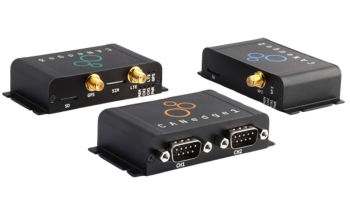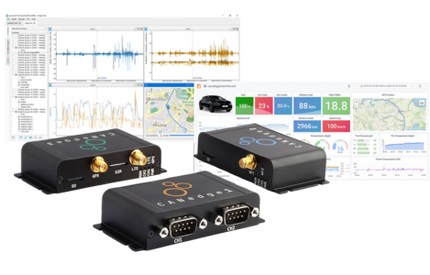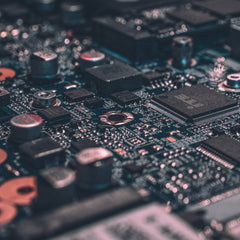
CAN Bus Diagnostics Q & A
Questions & Answers
Q: How can you identify if your CAN node does or does not have a Transceiver...?
A: All CAN nodes will have a transceiver. The transceiver converts the TTL level signal of the CAN controller to the bus level voltages.
Q: Is there any way to test the proper function of configurable internal resistors that don't measure 120 ohms when the device is powered down?
A: You should be able to test this if you know the configured resistance. You can check one end at a time or use ohm’s law for checking the resistance of the whole bus.
Q: I agree that using an oscilloscope is a better tool for getting bus voltages. If you only have a DMM available, does bus load and/or sampling rate of the meter affect the voltages observed?
A: The voltages will be affected by the bus load and CAN communication. It's best to check initial voltages when the device is idle. But even during active communication the voltages measured should be similar to idle.
Q: Is there anything that prevents using multiple CAN variants on the same physical wires, as long as they are the same baud rate? E.g. CANopen with 11-bit ID's and J1939 with 29-bit ID's.
A: Depends on the devices, but normally you would only have 1 higher level CAN protocol on a given network. Otherwise the devices would have to be able to filter out CAN IDs of the other protocols.
Q: What benefits are there, if any, to using a handheld diagnostic tool over plugging in with a USB-CAN device and using a computer?
A: The handheld diagnostic tool is definitely more portable with a user interface that easier to manage. The portable units also have oscilloscope features that are not available with our USB-CAN devices.
Q: Using PCAN view, can we see the voltage and resistance information we would see with the diag 1/2?
A: No PCAN View does not measure voltages or termination resistance on the bus. only allows data messages to be sent and received. Use the PCAN MiniDiag FD for that.
Q: Have you had any experience with windows based platform and a PCAN adaptor having timing issues with sending messages on time?
A: Several potential issues here. Windows has there delays getting the data to the PCAN USB via the USB interface. (usually small delay) The PCAN USB can send CAN data under 1mS. But this depends on the CAN bus load.
Q: What is the difference between ISO14229&J1939?
A: These standards are mostly different in their handling of diagnostic information and messaging.
Q: What device would be best for us to remotely access CAN data on a customer's machine?
A: Peak Systems PCAN USB and a Laptop.
Q: Can PCAN view show bus load?
A: By viewing CAN messages you can get a sense of the amount of traffic.. Does not have a measurement of BUS load. Recommend that you use the PCAN Mini-Diag FD.
Q: What are the voltage measurements on CAN-H And CAN-L?
A: For CAN-High Measure the voltage between CAN High and ground. Should be between 2.5 and 3.5Vdc.
For CAN-LOW Measure voltage between CAN Low and ground. Should be between 1.5 and 2.5Vdc.
Q: Will the CANedge1 work on a buss with 11 and 29 bit CAN?
A: Yes, it supports both 11 and 29 bit CAN IDs.
Q: Would be interested in a PCAN 6 Explorer seminar, we currently use that tool quite frequently.
A: We are looking into offering this class.
Q: Any white papers on CAN use for embedded electronics?
A: Infineon has some good white papers on this.
Q: I think you said something about sending messages with one of your tools. Do you have anything like C editor that send a message based on specific received data?
A: There is an API that will allow you to send and receive data through your own C Program using PCAN USB
Q: How can I find that we are using CAN2.0 or CAN FD?
A: Use a CAN diag tool to measure the bit rate
Q: There is a simple way to filter messages using PCAN tool at Peak CAN viewer? Other to use Trace function and manually analyzing it?
A: PCAN View will filter based on a range of CAN IDs, but will not filter on specific bits of the CAN ID.
Q: Does the Explorer 6 allow you to filter for CAN IDs? And if so, can they be set up to look for specific bits in the CAN ID rather than explicit CAN IDs?
A: Yes you can filter with PCAN explorer 6 based on CAN ID. Once you receive the packets you should be able to parse out the bits. Using the PCAN API would make this easier to do.
Q: What is the acceptable bus loading ? 50% - 70%?
A: Its suggested to keep an acceptable load of 50% on average. Peaks of 70% are acceptable.
Q: Referring to the Mini CAN FD device, you mentioned that it can return the bus terminating resistance. How and when is this test performed? and - Will it also measure the ground side resistance? (looking for possible lightening strike damage.)
A: It measures the resistance automatically when it is connected. probably calculating it by measuring the voltage and current load.
Q: Do you have any resource recommendations for people who are just starting into the world of control and data collection for (fairly simple) electro hydraulic systems and controls?
A: Take a CAN bus training class on line or in person.
Start time:
Duration:
Brought to you by
Meet the experts

Gary is a Sales Solution Architect for Grid Connect where he has worked for the last 2 years. He helps End Users and OEMS integrate IIoT solutions to their products and processes. He has worked with engineers to develop network communications at the edge as well as integrating actionable data to the cloud.
Latest Posts


CAN Data Logging Explained
by Grid Connect Team

Let’s Connect at CES 2025: Build Your Next IoT Success Story with Us
by Megan Hemmings
Get our monthly newsletter for product and technology updates




